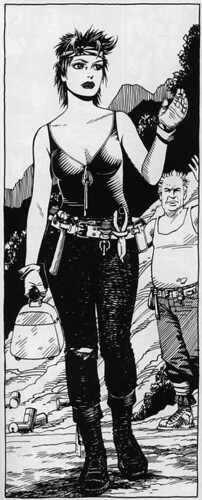Music for Mechanics
A LONG-WINDED BUT IMPORTANT INTRODUCTION
We all know how important Love and Rockets has been to the medium. As a relatively young comic reader, it's the body of work that has been the most consistently revered during my lifetime. Ranging from literary to masturbatory, each of us have our own personal reasons for loving the creations of Los Bros Hernandez. As a Mexican-American female, my bias is obvious: strong female characters, smashing Chicano stereotypes, stunning artwork, and impressive writing. In short, these were my comics. I was proud and touched and empowered and inspired from the first reading. I immediately went and procured the gigantic, muscle-building collections Palomar and Locas. But I felt like I was missing something. So I'm going back and reading the individual collected books. If I had a resource that would've broken down each volume into bite-sized morsels, I may have read these first, rather than jump feet first into the giant collected versions. So my project is a chronicling of what I feel is important in each book, some pivotal panels, and a quick rundown of what may have been omitted in the collected version.
MUSIC FOR MECHANICS
Mechanics: aka Mechan-x, Mechanicos. What is most important in this story is the maturation of Maggie from a star-struck mechanic assistant of Rand Race's to a traveled, tough woman who survives a near-death illness, family drama, political upheaval, homesickness, and romantic frustration. Maggie becomes one of the fiercest females in the Hernandez Bros universe: she's hot-headed, she's insecure, she's lustful, she's vulnerable, she is impulsive, and she doesn't take shit from anyone.

Locas: Here we see more of the ever-dynamic and complicated relationship between Hopey and Maggie, as well as how pivotal Izzy is to their friendship. Paramour undertones aside, Hopey and Maggie have the most realistic, adult relationships in comics: they fight, they love, they protect, they doubt, and they change.
How to Kill a: In my opinion, this is one of the most beautiful stories Jaime has drawn. The story, credited to Isabel Ruebens, is a glimpse into the strange and dark world that she inhabits. It's insular, it's weird, and it's destructive. We learn later why.

BEM: A sci-fi story Gilbert abandons after this collection. An important character we are introduced to is the larger-than-life Luba. She is that character that you cannot keep your eyes off of: she possesses a natural ability to lead and direct, she's brave to the point of danger, and she sacrifices many things to be held in high regard. She will later become a central character in Palomar.

Barrio Huerta: A single paged introduction to Hoppers (aka Huerta), where Locas takes place.
Penny Century, You're Fired: The quintessential fantasy woman comes to life and reveals more about herself than her perfect figure: insecurities, stubbornness, insatiable desire for adventure.
Radio Zero, Music for Monsters, and
Somewhere in California: A few collaborative sci-fi stories between Mario and Gilbert (though Somewhere... is mostly a Mario piece). I don't think any of these stories are particularly notable, except for Mario's involvement. Maybe that makes me a jerk.
A Little Story: The first glimpse of Palomar and the introduction of Pipo. As a child, Pipo is unaware of how strange it is for the traditional town of Palomar to see a little girl to play rough, not care what others think, and throw caution to the wind. In her innocence Pipo is not aware of how her defiance of gender constraints as a child will change the landscape of Palomar forever.




